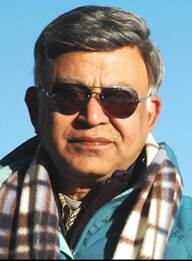By Samar Saha
e-mail: Â Â samar_k_saha@yahoo.com
Recently Pittsburghers had a rare opportunity to listen to two musical giants in one session in a recital arranged by the Pandit Jasraj Institute of Music on Saturday, July 19, 2014 at the Hillman Center of Performing Arts of Shadyside Academy. It was advertised as one-of-a-kind performance titled Alap-Jugalbandi between Padma Vibhushan Pt. Jasraj, the leading Hindustani vocalist; and Padma Bhushan Dr. L. Subramaniam, the leading Karnatic violinist. Music lovers were ecstatic waiting for the ultimate joy.
Why the expectation of ecstasy? With Jugalbandi literally meaning “entwined twins,†in the pan-Indian classical music recitals pairing two artistes, it has come to mean a mix of the best in both musical systems – either instrumental or vocal or any combination thereof.
Many relate to the Hindustani and Karnatic music systems with emotions — as “twins†born, nourished and brought up by the same loving mother, but departing in their adulthood like two streams — one keeping the original pure form and the other evolving into a different form by interaction with other musical systems. So, many expected the recital to bring the two genres of music together through the facile skills of the two veterans. The limitations associated with each system were forgotten. The general exuberant expectation was that these titans would overcome all constraints with their intrinsic understanding of the other’s system and present a performance that would be worth dying for.
The performance began close to the advertised start time of 6:30 PM, quite uncommon with Indian musical events. Pandita Tripti Mukherjee started the evening with Narayan, Ganesh and Kali Vandanas with Asish Sinha on the tabla and vocal support from Paromita Deshmukh, Nidrita Mitra Sinha, Anupama Mahajan, Babeena Sharma, and Sambhavi Desai. The invocations were both contemplative and soothing, setting up the mahaul (ambience) for the better and greater things to come.
As the audience settled down, the next artiste, the violinist Ambi Subramaniam, took the stage with Mahesh Krishnamurty accompanying on the mrdangam. The youngest son of Dr. Subramaniam, Ambi was proclaimed the ‘New King of Indian Classical Music’ by the Times of India when he was sixteen. Ambi began his recital with a Ganesh Vandana in a very auspicious Raga Nattai (close to Raga Jog in Hindustani music). He finished his performance with a Tyagaraja krti in Raga Nagaswaravali (close to Hindustani Khamaj) in Adi tala. Starting with a slow alapana (alap), the recital ended with a superfast and aggressive Charana. A few Karnatic music lovers expressed disappointment at this style of speed. One such connoisseur described Ambi’s closing piece as a “rock-concert type high-decibel ending†seldom done in an all-Indian traditional recital. It satisfied neither the puritans nor set the stage for the main event properly.
The main event was Alap Jugalbandi, which the MC announced, “will be presented in an extended Alap form but without any percussion accompaniment. No one has attempted a Jugalbandi like this except once in Chennai by the same artists.â€
Expectations surged. Would it be another wonder like Jasrangi Jugalbandi? Or would it be another blend where listeners could appreciate the mix of Hindustani and Karnatic styles?
The artistes did not explain how the Jugalbandi would unfold. Jasraj-ji started with Ati Vilambit (very slow) alap in the Raga Puriya Dhaneswari (Karnatic equivalent Pantuvarali), a raga most suited when we transition from evening to night. The choice could not have been any better.
A few minutes into the alap, it appeared Jasraj-ji was struggling with his voice. The optimist in me said, “He’ll come back roaring as soon as his voice clears.†He has done it before. Subramaniam-ji provided the needed support but his role appeared more as an accompanist. I had exepected the violin to pick up Pantuvarali, but that did not happen. Jasraj-ji completed the long alap apologizing “Thodi Taqlif ho rahi thi†(Was having some difficulty).
The Jugalbandi continued in Raga Malika seamlessly gliding from one Raga to the other – starting with Kaafi, moving into Bahar, and ending with Bhairavi. As he wove through the ragas, exposing the mukhras (face) of each, Subramaniam-ji followed on his magic violin with pleasant and melodious improvisations. The main event lasted about 1-1/2 hours.
The unfulfilled expectations from this pricey concert was on each face as the silent crowd left. I sympathize with the frailties of old age — particularly with the voice of an octogenarian veteran vocalist. We who adore Jasraj-ji with pride were wondering — How was this veteran feeling at the end of the show?Â
The idea of Alap Jugalbandi without the percussion instruments may have been fine, but the execution came out poorly. A distraught friend told me, “To pull off the best in a Jugalbandi like this, the artistes need more than raga and its presentation. The listeners like to witness harmony, camaraderie and musical repartee between the artistes,†something that just was not there.
He added, “You need a Plan B, if things start waveringâ€. There lies a lesson for the concert organizers. ï®

